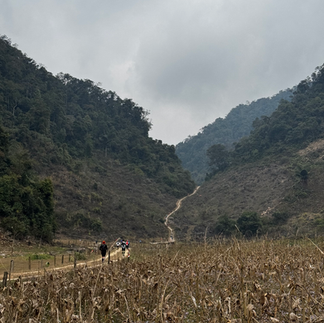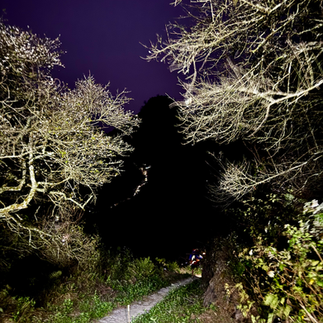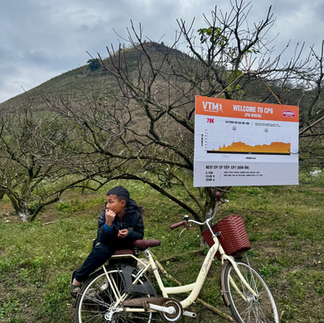My first 70KM trail marathon
- Hoang Nguyen
- Jan 18
- 4 min read
Let’s talk about how I found myself running the Vietnam Trail Marathon (VTM) 70KM—a decision fueled by a desire for challenge, growth, and the motivation to push my limits—and how I completed the race with valuable insights and lessons learned.
The Backstory: Moving Beyond 50KM
In October 2024, I participated in my second 50K at the Mu Cang Chai Ultra Trail (MCC 2024). My primary goal was to enjoy the stunning scenery, but I ended up achieving a sub-10-hour finish, surpassing my expectations. Encouraged by this result and support from friends and fellow runners, I decided to take on a greater challenge: the 70KM race at VTM 2025.
Deciding to attempt a longer distance wasn’t just about testing my physical limits. It was also about exploring what I could achieve mentally. Running ultra distances demands a level of resilience and adaptability that goes beyond the miles you log. That’s what drew me to the challenge—not just crossing the finish line, but the journey of becoming a better runner and a stronger person.
The Preparation: Structured Training and Lifestyle Adjustments
After MCC 2024, I knew that preparation for a 70KM race would require more than just running. It required a balance of structured training, recovery, and mental readiness. My preparation included:
Races: Completing a half-marathon a week after MCC, followed by a max-effort 10K (56 minutes), another half-marathon (2 hours, 1 minute), and a full marathon (5 hours, 35 minutes in zone 2). These races helped me build a solid aerobic base while testing my pacing and endurance.
Weekly mileage: Averaging 25-40KM, peaking at 60KM during race weeks. While my mileage wasn’t exceptionally high, I focused on quality runs and ensuring I stayed injury-free.
Lifestyle: Prioritizing quality sleep (9 hours per night), eating well, and maintaining a relaxed routine. I reduced gym sessions, avoided music during runs, and stopped tracking water intake, instead listening to what my body needed.
I also adopted Kilian Jornet’s training principles, focusing on efficient movement and time on my feet rather than chasing arbitrary mileage goals. This approach kept me motivated and injury-free, even during higher-intensity weeks.
Key Insight: Consistency and listening to my body were critical to building a solid foundation, even with moderate weekly mileage.
The Week Before: Final Preparations
In the week leading up to the race, my focus shifted to recovery and mental preparation. I reduced my running volume, avoided heavy sessions, and made deliberate efforts to keep stress levels low. This included cutting back on caffeine, ensuring I slept well, and eating heavier meals to fuel my body for the challenge ahead.

My nutrition plan was straightforward yet effective. I aimed to consume 4,000 calories during the race, with a strategy to eat 200-250 calories per hour. My fueling essentials included:
Tailwind Endurance: 9 servings
Tailwind Recovery: 2 servings
Gels: 10 (8 Maurten, 2 others)
Checkpoint food: Supplementing with real food as needed
In addition to physical prep, I mentally rehearsed the race—visualizing the terrain, checkpoints, and potential challenges. This gave me a clear strategy for pacing and nutrition while building confidence for the task ahead.
The Race: Navigating Terrain and Challenges
The VTM 70KM course was as beautiful as it was demanding. With 49 hill climbs, technical descents, and varying terrain, it was a test of both physical and mental endurance. Temperatures ranged from a chilly 4°C at the start to a manageable 10°C midday, dropping back to 6°C as the race progressed.

Start to CP2: The race began with a grueling 500 meters of elevation gain in the dark. My headlamp illuminated the narrow trails as I relied on my poles to power through. Alternating between engaging my quads and calves helped conserve energy, and by the time I reached CP2, I was relieved to be an hour ahead of the cutoff. Meeting Sengi Sherpa, a trail running legend, at this checkpoint was an unexpected morale boost.
CP2 to CP4: This stretch featured flatter terrain, allowing me to pick up the pace (8-9 min/km). However, I quickly realized that retaining my extra layers was a mistake. The cold weather made it difficult to sweat efficiently, but I chose warmth over risking hypothermia. By the time I reached CP4, my mental fatigue was evident. I spent extra time at this checkpoint to eat, rest, and reset my mindset before pressing on.
CP6 to Finish: As I approached CP7, pain in my left IT band began to surface. Although I could still run, I decided to play it safe and walked the remaining distance. Reduced nutrition intake during this phase impacted my mental resilience, making the final stretch a battle of willpower. Crossing the finish line was a mix of relief, exhaustion, and pride.
Post-Race Reflection: Key Learnings
Training Volume: My base mileage was insufficient for 70KM. Increasing volume and incorporating strength training will be priorities for future races.
Nutrition: While adequate, my fueling strategy could benefit from including more real food options at checkpoints.
Techniques: Efficient use of poles and proper uphill/downhill strategies significantly reduced muscle strain.
Mental Strength: Support from friends and strategic checkpoint pauses were invaluable for maintaining motivation.
Clothing: Choosing appropriate layers was essential for managing the cold and maintaining comfort.
Moving Forward
This race was more than just a test of endurance; it was a journey of self-discovery. I’ve learned that pushing limits requires not only physical preparation but also a resilient mindset and a willingness to adapt. While I’m shelving longer distances for now, my focus will be on improving speed, building muscle, and refining my overall conditioning. Future goals, like UTMB, remain on the horizon, but for now, I’m taking time to recover, reflect, and plan my next steps.
To my fellow runners and adventurers, remember: every race is a story, and every story is a stepping stone. Cheers to the trails ahead!




















Comments